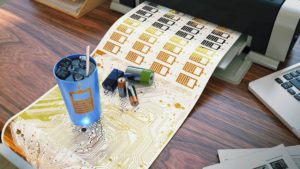Hacking a Desktop Printer to Make Batteries and Circuits
 Under a bench at Sang-Young Lee’s lab is an ordinary, somewhat beat-up ink-jet printer he has modified so that it spits out electronic circuits and a type of energy storage device called a supercapacitor. To make it work, Lee empties the ink cartridges and refills them with specially formulated battery materials and conductive inks. When loaded with treated paper, his hacked printers make flexible, durable supercapacitors and simple circuit components in the form of a high-resolution map of the Republic of Korea, a flower, a logo, or any other desired design.
Under a bench at Sang-Young Lee’s lab is an ordinary, somewhat beat-up ink-jet printer he has modified so that it spits out electronic circuits and a type of energy storage device called a supercapacitor. To make it work, Lee empties the ink cartridges and refills them with specially formulated battery materials and conductive inks. When loaded with treated paper, his hacked printers make flexible, durable supercapacitors and simple circuit components in the form of a high-resolution map of the Republic of Korea, a flower, a logo, or any other desired design.
Lee, a battery chemist at the Ulsan National Institute of Science and Technology (UNIST) in South Korea, has been working on flexible printed batteries for the past five years. “The architecture of the battery hasn’t changed since the birth of the lithium-ion battery,” he says.
To make it work, he had to tailor all the materials in the recipe. If the inks smear or run in the paper, the supercapacitor won’t work. So the first layer to be printed is a cellulose primer that absorbs inks and won’t run. That’s followed by carbon nanotubes, which replace the foil current collector in a battery, and silver nanowire electrodes, followed by an electrolyte ink. Each ink had to be formulated so that it would flow through the print head and not clump up while sitting in the cartridge.
Lee’s prototype, described in the journal Energy & Environmental Science, shows how the battery and the circuit alike disappear into printed designs. On one printed sheet, the word “BATTERY” powers the words “Printed Circuit,” which carry electricity into an LED. In a design for a coffee-mug wrap, a supercapacitor powers a sensor to turn on a blue light by the printed word “COLD” or a red light by the word “HOT” depending on the beverage’s temperature.
“The goal for the Internet of things and ubiquitous computing is to have technology go into the background so we can interact with the world in ways that feel natural,”...
See the full story here: https://www.technologyreview.com/s/601800/hacking-a-desktop-printer-to-make-batteries-and-circuits/
Pages
- About Philip Lelyveld
- Mark and Addie Lelyveld Biographies
- Presentations and articles
- Tufts Alumni Bio